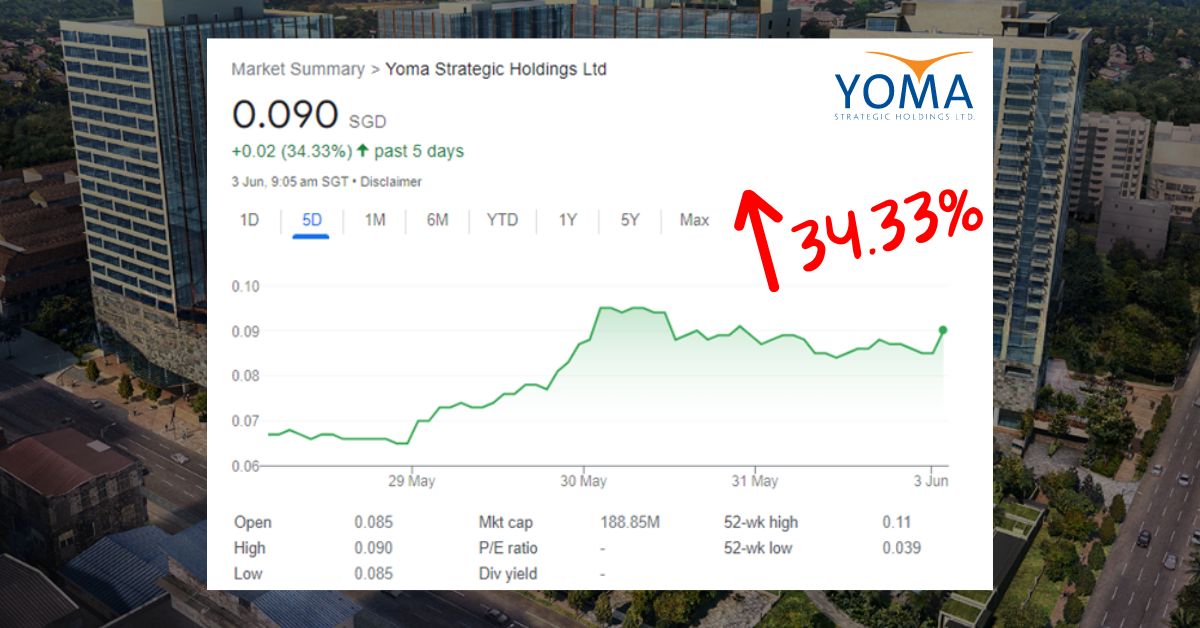
Yoma Strategic Holdings (SGX: Z59) has risen over 30% in just a week on significant trading volume. 97 million shares were traded on 29 May 2024, which is about 4% of its total shares outstanding. Share prices have also more than doubled from its 52-week low recorded just 2 months ago.
Yoma delivered strong results in its latest financial year. Revenue grew by 79% YoY, reaching US$220.8 million in FY24 as compared to US$123.6 million in the previous year. Core EBITDA increased by 161% YoY, rising to US$45.8 million from US$17.6 million. Net profit reached US$21.2 million, marking a remarkable turnaround from a net loss of US$63.3 million in the previous year.
| Revenue (US$’m) | FY24 | FY23 | Variance (%) |
| Yoma Land Development | $94.1 | $45.8 | 106% |
| Yoma Central | – | – | – |
| Yoma Land Services | $17.1 | $10.8 | 58% |
| Yoma Motors | $11.2 | $11.3 | -1% |
| Leasing | $8.0 | $4.7 | 70% |
| Mobile Financial Services | $52.4 | $19.7 | 166% |
| Yoma F&B | $31.9 | $24.5 | 30% |
| Investment | $6.2 | $6.8 | -9% |
| Total | $220.8 | $123.6 | 79% |
The two major segments contributing to the 79% revenue growth were Yoma Land Development and the Mobile Financial Services segment, which mainly consists of its Wave Money business.
Yoma Land Development’s revenue was driven by construction progress as well as the handover of completed projects. Yoma Land Development has unrecognised revenue of $147 million to be realised over the next 1.5 to 2 years from units sold and under construction.
The Mobile Financial Services division is seeing higher transaction sizes with the adoption of the WavePay app, with 11.4 million users, which is about 20% of its population. There are also more than 200,000 QR merchants on the app. Wave Money also now provides international remittance services to facilitate money transfers back to Myanmar.
It is also worth mentioning that Yoma F&B remains the largest restaurant operator in Myanmar with FY24 revenue growing by 30% YoY to US$31.9 million.
Profit contribution by segment:
| Net profit (US$’m) | FY24 | FY23 | Variance (%) |
| Yoma Land Development | $22.9 | $1.8 | 12x |
| Yoma Central | -$23.0 | -$46.6 | 50% |
| Yoma Land Services | $53.9 | $3.3 | 15x |
| Yoma Motors | -$0.8 | $0.9 | N.M. |
| Leasing | -$2.6 | -$1.2 | -117% |
| Mobile Financial Services | $3.7 | $2.2 | 68% |
| Yoma F&B | -$0.6 | -$1.4 | 57% |
| Investment | -$17.3 | -$2.9 | N.M. |
| Others | -$14.9 | -$19.3 | 23% |
| Total | $21.2 | -$63.3 | N.M. |
The biggest profit contributors are the Yoma Land Development and Yoma Land Services segment. Yoma Land Development recorded corresponding higher profits off the back of higher revenue. Yoma Land Services recorded substantial fair value gains across its investment properties as well as higher estate management fees.
Spotlight on Yoma
Likely because of the strong performance, CNBC carried out an interview with Yoma’s CEO Melvyn Pun. Yoma’s CEO shared about the financial performance and prospective plans.
The CEO’s highlights mentioned during the interview include:
– Good FY2024 results with growth across the board
– Strong revenue backlog from Property sales to be recognised in the coming year
– Covid-induced cost discipline & remote work continue to benefit Yoma Strategic Holdings
– Commitment to further de-leveraging
– Opportunities to serve overseas Myanmar workers – Wave Money international remittance efforts & YKKO Group of Companies, Ltd.
The interview is available on Yoma’s CEO’s linkedin profile here.
Is this the turnaround for Yoma?
Yoma is now focused on pursuing strategic growth opportunities across its core businesses. Perhaps due to the uncertain environment in which it operates, Yoma remains focused on disciplined cost management, generating positive operating cash flow, and reducing leverage to underpin its pursuit of strategic growth opportunities across its core businesses.

Yoma has taken steps to reduce its debt and deleverage its balance sheet with its operating cash inflows.
Earnings per share for FY24 stood at 0.8 cents, and operating cash flows before changes in working capital was $45.5 million, compared to negative amounts a year before. This allowed Yoma to repay borrowings and reduce its interest expenses amidst a higher interest environment.
Net asset value is now at 16.4 cents compared to 26.8 cents as at September 2020 and 29.3 cents as at March 2019. Asset values have significantly deteriorated due to valuation losses and the depreciation of the Myanmar Kyat.

Yoma was trading at $0.28 in January 2021, just before protests started after a Coup D’etat, and is now trading at 70% below this price. It is also now trading at about 0.4x book value as compared to 0.8x book value then.
Is it time to buy Yoma?
An overview by the World Bank of the country notes that from 2011 to 2019, Myanmar experienced high economic growth, averaging 6% per year. 2020 was the year of Covid and Myanmar’s GDP fell by an estimated 9%. In 2021, after the Coup, Myanmar’s GDP fell by an estimated 19%, an even steeper decline.
The Asian Development Bank expects Myanmar to grow 1.2% in 2024 and 2.2% in 2025, one of the slowest, if not the slowest, in the ASEAN region.
Yoma’s all time high share price was nearly $0.90 in June 2013. While it is unlikely that Yoma will return to its all time high, it seems that Yoma has bottomed out and will start to thrive in the current environment. In this regard, Yoma is a buy at current prices, but it is worth being cognisant that, for now, there are limits.

